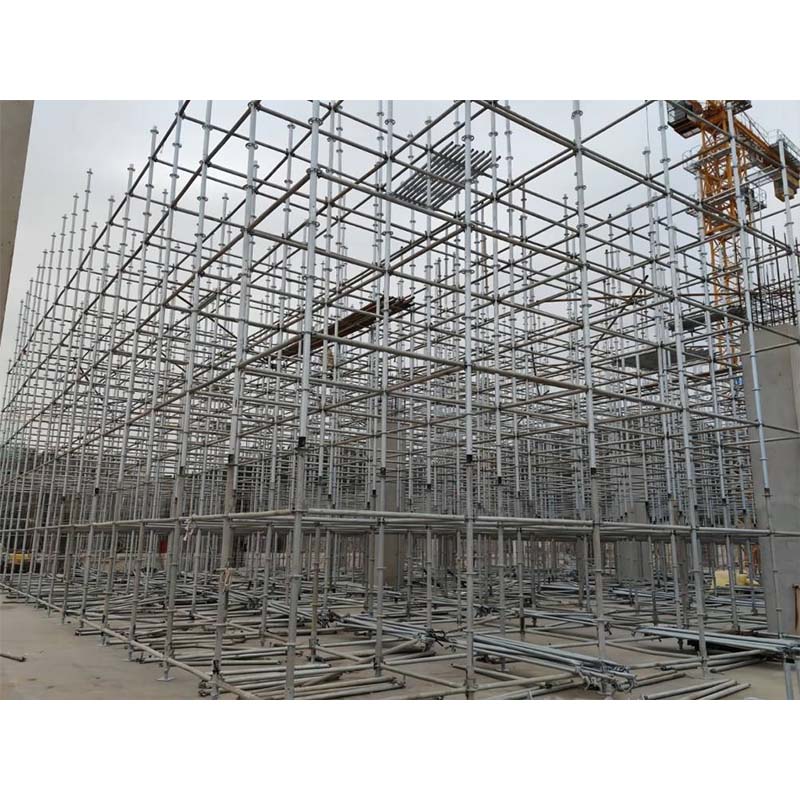फरवरी . 27, 2024 12:28 Back to list
10 Types of Scaffolding Used by Construction Workers
Scaffolding is an intricate framework of wood or pipes that allows construction workers to build and maintain structures safely. Proper scaffolding is safe to use and durable enough to hold the weight of construction workers and their equipment. If you work in a construction position that involves using scaffolding often, it may be beneficial to learn about different types of scaffolding. In this article, we explain what scaffolding is, discuss different types of commonly used scaffolding and list jobs that often use scaffolding.
Ringlock Scaffolding System For Construction
What is scaffolding?
Scaffolding is a multipurpose and temporary structure of wood, pipes or poles that supports a structure and functions as a platform for construction workers to maneuver safely while working in elevated positions. Scaffolding is primarily present at construction sites and is composed of timber and steel. Properly constructed scaffolding is often sturdy, stable and strong enough to support the weight of construction workers and the materials placed upon it.
Types of scaffolding
Scaffolding is an essential element for most construction projects. Construction workers use different scaffoldings depending on the specific needs of a construction project, each of which typically has its own unique qualities and benefits. The following list details different types of scaffoldings you may find at a construction site:
Single scaffolding
Single scaffolding stands parallel to a wall of a structure by using vertical supports called standards. Ledgers, the horizontal supports, connect to the standards at an even vertical angle. Putlogs are the holes in the building or structure through which the scaffolding connects for support. The most common use for single scaffolding is brick masonry.
Double scaffolding
The primary use for double scaffolding is stone masonry because stone walls present challenges when trying to create holes for putlog anchoring. In this type of scaffolding, a double row of scaffolding makes the entire support structure stronger. The first row sits parallel to the wall, while the other row sits away from the first row. Added putlog holes support the frames. Rakers and cross braces provide additional support to the scaffolding.Rakers are a type of tie that sets the scaffolding securely to a building, and cross braces hold a part of the scaffolding in a fixed position in relation to another part of the scaffolding or some other structure.
Cantilever scaffolding
Construction workers use cantilever scaffolding when the ground is strong enough to support standards and when a wall's upper level is under construction. The standards receive support from needles, which are protrusions sticking out from a structure on which a platform sits. Workers remove the needles from holes in the structure. This type of scaffolding is often more unsteady than other types, so taking extra precautions might be helpful while constructing it.
Suspended scaffolding
Wires and chains suspend this type of scaffolding platform from a structure's roof. A lever or electronic system allows the platform to raise and lower as needed. Painters, window cleaners and repair positions commonly use this type of scaffolding.
Trestle scaffolding
This type of scaffolding includes a platform that sits on top of a ladder with wheels for maneuverability. It varies in size and is useful for outdoor and indoor purposes. Repair positions, maintenance workers, warehouse workers and painters regularly use trestle scaffolding.
Steel scaffolding
Steel supports adhered together with couplers comprise steel scaffolding. This type of scaffolding is simple to construct and dismantle. Because it's made of steel, this scaffolding is more durable, sturdier and more fire-resistant than other types.
Patented scaffolding
Patented scaffolding benefits from a steel composition and comes equipped with special couplings that lock supports firmly together. The working platform sits on height-adjustable brackets.
Wooden and bamboo scaffolding
Wood and bamboo scaffolding are more common in Asia than anywhere else in the world. These scaffoldings are notable for their flexibility and eco-responsible nature. Technicians and proficient designers construct and move through layers and stories of bamboo scaffolding while working on structures.
Tube and clip scaffolding
This is a steel-based scaffolding that is easy to assemble. It simply requires connecting supports to form long pole runs and then standards and ledgers connected with clamps made specifically for these supports. This scaffolding is popular because you can move the ledgers wherever necessary and adapt its form to irregular and oddly shaped structures to reach several different locations.
Kwikstage scaffolding
Kwikstage scaffolding is popular because it's adaptable to commercial and residential projects and is fairly easy to construct. It has a non-slip platform and double guard railing, which makes it safe for construction workers and reliable enough to place equipment upon. Galvanized steel comprises this scaffolding, allowing for sturdiness and a durable interlocking system. The system is also customizable and adjustable for any height.
-
High-Quality Wall Formwork Systems for Versatile Concrete Construction
NewsJul.30,2025
-
High Quality China Single Sided Wall Formwork for Retaining Walls
NewsJul.30,2025
-
China Single Sided Wall Formwork Manufacturer for Retaining Walls
NewsJul.29,2025
-
High-Quality Scaffolding Jacks for Stable and Safe Support
NewsJul.29,2025
-
Adjustable Heavy Duty Props for Slab Formwork – Reliable Support Solutions
NewsJul.29,2025
-
Adjustable Heavy Duty Props for Slab Formwork - Reliable & Durable Support
NewsJul.28,2025
